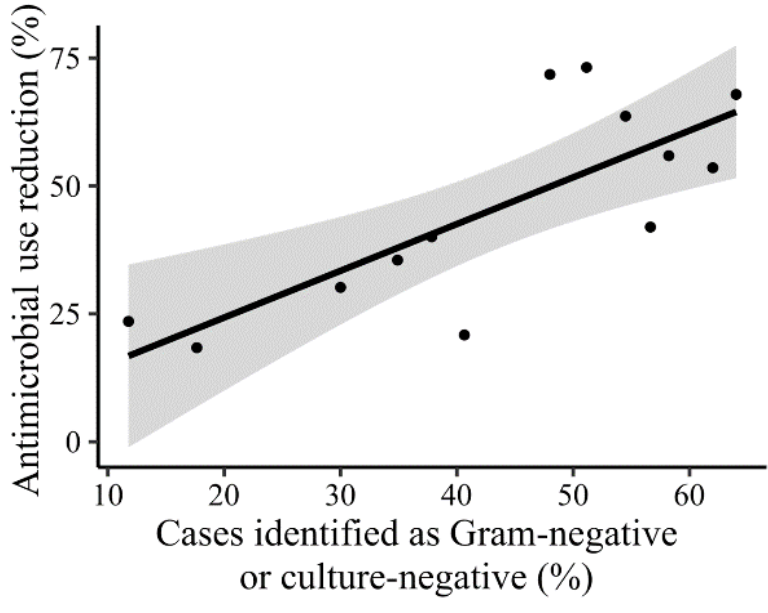There is a strong association between antimicrobial consumption in livestock with antimicrobial resistance (AMR) in consumers’ and politicians’ mind leading to an incredible societal pressure.
In the last decade, regulatory bodies have taken actions to encourage reduction of antimicrobial use (AMU) in both livestock and companion animals, especially at EU level. This has resulted in a tremendous reduction of 47% of AMU in 10 years!
Looking at dairy, 70% of AMU sits in udder health management: treatment of clinical mastitis (CM) and dry cow therapy (DCT). Selective DCT has now been promoted for about more than a decade, and we see slow adoption by farmers because most of them hold strong negative beliefs about the consequences.
The main principle of selective antimicrobial treatment of non-severe cases of CM is to treat only cases with a high probability to be responsive to antimicrobials (e.g., Gram-positive CM).
The objective of selective CM treatment sits in not treating CM cases that will not benefit from antimicrobial treatment. This is excluding severe cases and considering potential causal agent with high spontaneous cure rate (e.g., culture negative and most of Gram-negative cases).
It is then crucial to have an accurate identification available within 24 h after detecting the case. Several commercial rapid diagnostic tests are available that can identify causal agent, predominantly based on culture and identification via selective media on plates or in tubes. Sensitivity to identify Gram-positive bacteria ranges from 59 to 98%, and specificity ranges from 48 to 97%.
Expected probability of cure: cow SCC level and CM history can be used to identify CM cases with high probability of cure, together with the results of rapid diagnostic tests (Gram-positive or Gram-negative).
Susceptibility profiles: Identifying whether causal bacteria of a CM case are Gram-positive or -negative is key in a selective treatment strategy.
Supportive treatments: In addition to treating pain, NSAIDs can have other benefits: lower rectal temperatures, lower heart rate, and improvements in rumen motility and clinical signs. Other types of supportive treatments are sometimes considered in CM treatment protocols, however, there are insufficient studies to evaluate their effectiveness.
Cow and farm outcomes of implementing a selective CM treatment protocol:
- Udder health: a recent systematic review and meta-analysis, that reviewed 13 studies comparing selective treatment protocol impacts on udder health parameters to a blanket treatment protocol, concluded that for bacteriological cure, a selective protocol was not inferior. Furthermore, the review found no evidence to assume a difference between cases in terms of new infection risk, recurrence of CM later in lactation, return of SCC to baseline, average milk yield, and risk of culling.
- Antimicrobial use: the same review reported variable AMU reduction: for a 10 percent point increase in proportion of cases identified as Gram-negative or culture- negative, proportion of reduced AMU increased by 9.1 percent point (95% CI: 0.4 – 14.1%).

- Economic consequences: potential benefits to selectively treating CM cases were described as reduced treatment costs and reduced days out of the tank. A selective treatment protocol based on on-farm culture results was still beneficial if < 50% CM cases were Gram-positive. Most important factor influencing costs was the differences in days out of the bulk tank.
Prospective
Adoption of selective clinical mastitis treatment protocols is widely encouraged in EU. Implementation of on-farm rapid diagnostic tests require substantial motivation and dedication from producers and their staff. Properly using and interpreting on-farm tests are essential and require training and frequent practice, a sufficiently high number of CM cases per month may be necessary to maintain knowledge.
Investigating the potential for NSAIDs to replace antimicrobial treatment for mild and moderate cases could have a positive impact on animal well-being.
Diagnostic accuracy of several on-farm rapid diagnostic tests is not optimal. Polymerase chain reaction (PCR) technology can be used as an alternative rapid diagnostic test to culture-based methods.
The predictive ability of SCC and CM history to identify CM cases with a low probability of clinical cure is lacking specific thresholds.
No studies evaluating selective versus blanket CM treatment protocols have been conducted on farms with automated milking systems.
To promote selective CM antimicrobial treatments, it is important that protocols are easy to understand and tailored to the farm-specific context. This will also need an understanding of the target group’s motivations, opportunities, and social influences.
Finally, not all CM cases benefit from antimicrobial treatment, therefore identifying cases who do benefit is key to supporting judicious AMU in dairy. Characteristic and history of the herd and individual cow and fast basic identification of causative pathogen are needed for treatment decision. Literature did not report any negative udder health consequences and adding NSAID improved outcomes, and no negative economic consequences.
Uptake depends on legislation, management systems and adoption of control programs. Level of AMU reduction depends on pathogens responsible for CM.
